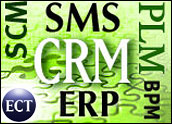
Even at post-tech bubble prices, adopting a CRM system requires a sizable commitment for any firm. Many of the companies making these investments, though, still are not realizing the maximum value for their money due to common missteps before and after the implementation.
Some firms, for instance, approach CRM from strictly a plug-and-play perspective. The typical — and erroneous — reasoning goes like this: “We have already installed XYX application. What works best with it?”
Conversely, some companies lean too far in the other direction, obsessing over business practices without regard to the underlying tech platform. They fail to properly assess the potential value of solving a particular business problem.
After the implementation, a whole other series of frequent mistakes loom — ranging from poor maintenance to inadequate training.
Selecting an Application
It is the poor decisions made before a project ever gets underway, though, that are most likely to lead to its failure. The most common appears to be taking a short-sighted approach to selecting a CRM application.
Many companies still compartmentalize the technology platform, the information that must reside in that platform, and the surrounding business processes as separate decisions or steps to be made. A successful CRM implementation, Yankee Group CRM analyst Sheryl Kingstone tells CRM Buyer, requires that all three be considered at the same time.
Kingstone can always tell when a client has ignored the processes or data issues that must be part of any tech platform selection.
“A company might ask for a shortlist of three CRM vendors that can, for instance, integrate with Microsoft Outlook and have e-mail campaign functionality,” she noted.
“What they should start with are the goals that are to be reached with the new technology, such as improving sales or improving customer retention. Only after that should they say, ‘This is what I have already in-house — what can work with it?'”
A lot of companies tend to think too much about the business process that the tech platform supports and not enough about the platform itself, cautions Kingstone. “Living with old technology inhibits good processes and doesn’t empower the end user or result in good data.”
Easy Shortcuts
Selecting a CRM system should not be centered around what application can best connect to an existing system, agrees Yacov Wrocherinsky, founder and CEO of Infinity Info Systems. That said, companies should not underestimate the importance of selecting a system that supports the way the business works, he told CRM Buyer.
To get the best value of out of a CRM system, companies “should select something that is easy to use,” he recommends. “Many firms buy applications with all these features that they wind up not even needing.”
Features to look for include — yes — an application that can easily be integrated into a pre-existing IT backbone. A company must not stop there, Wrocherinsky added. Other important features include an application that is easily customizable and that can scale up as a firm grows.
If there is a vertical or industry-specific application available, it is usually a smart choice to opt for it. “The days of generic applications are over,” Wrocherinsky pronounced.
At bottom, “companies need to find a system that allows employees to be more productive on a day-to-day basis,” he advised, noting that if that mandate is adhered to from the start, a company is bound to get the best value from its selection.
Properly Valuing Goals
Organizations definitely make the selection part of the process harder than need be, usually by conducting a top-down, extensive review of the systems and processes in place, Beagle Research Principal Denis Pombriant told CRM Buyer.
Instead, what can be very effective is examining what business processes need help, he said, and then putting a value on that. “What you don’t want to do is start out with a specific ROI (return on investment) number in mind as a goal. That is too nebulous.”
Ignore what is considered the norm for a particular industry or process, Pombriant suggested.
“If, for example, you are only closing one out of every 20 deals per sales rep and you want to close one out of ten, then make that a goal. Once you have a series of goals like that, then you can intelligently talk to vendors about what their solutions offer and how they will meet those goals,” he advised.
The company that is closing one out of every 20 deals per sales rep and wants to double that rate would have a rough ROI to work toward. Say every sale brings in $1 million. By doubling the close rate, the sales reps will bring in $2 million during the same time frame. With these numbers in mind, a company can decide whether a $1 million application and implementation project would be worth the investment, Pombriant said.
“Quantify what you want to do at the beginning of the project — that is the only way to get a true ROI,” he asserted.
“So many organizations don’t do this first step and then do the second step by sticking a wet finger in the breeze. But if a company has good handle on what it wants to accomplish and what those goals are worth, it will have a much better shot of actually reaching them.”














































